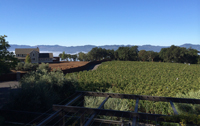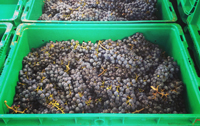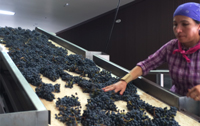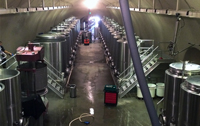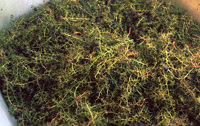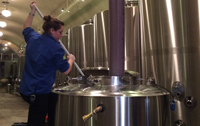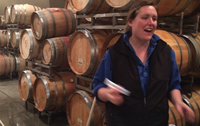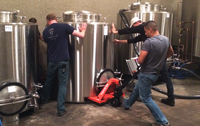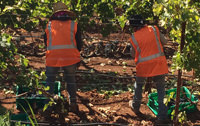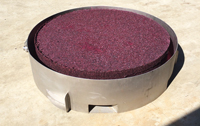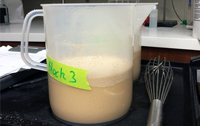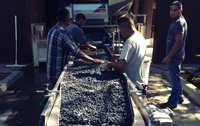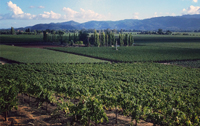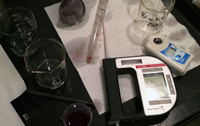My favorite thing about harvest is the intoxicating aroma. Like some kind of exotic pie, it’s a mix of over-ripe tropical fruit and fresh-baked pastry dough. It permeates the air, and every time I smell it, it sends a little shiver of joy down my spine.
Many things about harvesting grapes and making wine seem very romantic, but in actual fact it’s a fairly grueling, manual labor intensive, messy job. Growing grapes is a lot like growing any other crop — tomatoes, corn, you name it — it takes a lot of hours, usually under a hot sun, tending the vines throughout the growing season. Even if you take meticulous care of the vines, an entire year’s crop can be ruined by a hailstorm, or by heavy rains, or by too much sun at the wrong time. And even if the weather cooperates, harvest itself is backbreaking labor. Fruit picks can begin as early as 1am, and crews are routinely in the cellar late into the evening — longer if something isn’t going quite right.
And yet despite these decidedly un-romantic things, harvest is an incredibly exciting time that drives much of what happens during the other nine to ten months of the year. People travel to wine growing regions all over the world to witness and participate in it. This includes an international community of traveling winemakers and interns who hopscotch around the globe, often working two (and sometimes even three!) harvests a year in the northern and southern hemispheres.
What is it that brings all these people together to work 80-hour weeks of strenuous labor? For some, it may simply be a paycheck. And indeed the wine industry in Napa sustains a large pool of manual labor for whom the joy of wine may not be the driving force that wakes them up in the wee hours of the morning.
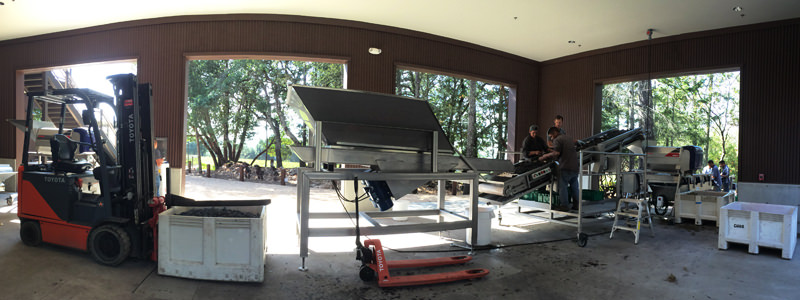
But for many, it is. As an intern put it to me recently, it’s about the personal satisfaction of seeing “a single cluster of grapes come in and in two months time you have a young red wine in a barrel that has the potential to become something beautiful — being able to witness that transformation, tasting the grapes as they come through the sorting table, tasting the must daily during fermentation and then later when it’s been pressed and put into barrel, being able to see where that wine is going and what it will become. It’s like taking rocks out of the mountain and turning them into a beautiful piece of jewelry.”
My friend who said those words, Matilda Scott, is from Australia and this is her second harvest in Napa. She’s worked two other harvests in Coonawarra (in South Australia) as well as one earlier this year in New Zealand. Next spring she’ll be back in Australia working in the Barossa Valley, home of some of that country’s top Shiraz/Syrah. In the summer she plans to start a Masters of Oenology and Viticulture at the University of Adelaide, the premier school in Australia. Her goal is to become a winemaker.
For her, working harvests all over the world is a way to broaden her scope and knowledge and further her career. As one of several harvest interns that have been brought on at Arkenstone, a small winery on Howell Mountain in Napa Valley, Matilda arrives in the cellar daily around 7am and often doesn’t leave until well after sundown. Here’s what a day in the life looks like for her:
7am – 10am: Arrive at the winery and being the morning rounds, checking on all the tanks that are fermenting or cold-soaking. This includes “cap management” to make sure that the “cap” of red grape seeds and skins remains integrated with the fermenting grape juice below. Mostly this is automated, but some containers require manual “punch downs” where the cap is literally punched down using a large stainless steel hammer. Meanwhile, up on the crush pad, grapes are arriving from all over Napa to be sorted and begin the transformation into wine.
10am – 12pm: Check on each fermenting tank to measure temperature, brix (grape sugars), bacteria and other variables. This might also include taking samples to send to the lab for testing. After doing all the measurements, everything must be logged in a central database.
12pm – 12:30pm: Lunch break
12:30pm – 4:30pm: If there are inoculations to do that day (meaning, yeast that needs to be added to grape juice to start fermentation), Matilda will rehydrate the yeast (it looks a lot like dry bread yeast) and add it as necessary. The balance of the afternoon is spent helping out running the cellar including pressing wine, more punch downs, barrel management, sorting grapes as they come in, monitoring the 2013 wines, and doing whatever else needs to be done.
4:30pm – 7:30pm or later: Evening rounds begin with more punch downs, monitoring and measurements of fermenting wine, and temperatures adjustments. Finally, the entire facility is cleaned, so they can start again in the morning.
With such long work hours, it’s not hard to see where the term “harvest widow” comes from. It’s a running joke among the winemaking community that during harvest you see far more of your work colleagues than of your family or significant other. It’s also clearly not a laid back, glamorous job – unless your idea of glamor is hauling around huge half-ton bins of grapes and then picking out stems while trying not to get stung by all the wasps and yellow jackets buzzing around.
If you think that anyone who wants to spend their time this way is nuts, you may well be right. But, as Matilda said, it’s also incredibly rewarding to see wine go from grape to bottle and to be part of that transformation. Harvest is by far the busiest time of year in wine country, and much of the rest of the year is spent preparing for or dealing with the aftermath of it. It is a time of transformation, both an end to the growing season, and a beginning of that vintage’s life as a wine. Harvest is also a stark reminder that wine is, at its core, an agricultural product that requires the blood, sweat, and tears of many people to come to fruition. If you ever feel intimidated by wine, or if it ever feels too complicated or erudite to enjoy, this is an important point to keep in mind.
Adrienne is a native New Yorker who now lives in Napa with a penchant for all things food & beverage. Previously she co-founded Dipsology, a guide to great cocktails in NYC, and she is also a Certified Sommelier. Follow her on twitter @alstillman.
![Harvest in the Napa Valley [WITH SLIDESHOW] Harvest in the Napa Valley [WITH SLIDESHOW]](https://vpstats.vinepair.com/wp-content/themes/miladys/src/assets/images/article-card-small.png)
















